Afroasiatik – a kung-fu hip-hop larp – recap part 2
Warning: long posts ahead. Read the short version here.
Part 1: the original reason for the game, a history of French hip-hop and its Asian influences
Part 2: how inspiration sources were used to build a game world that featured kimono-wearing rappers in a European zen garden
Part 3: the performance aspect of the larp and what worked, what didn’t
Beyond IAM
I did not want Afroasiatik to be an IAM-only larp. It would have meant incorporating ancient Egyptian pharaohs, Marseille pride etc, which started to be a lot considering I was already mixing hip-hop and a pop culture view of Asia. Note that if you organize a larp fully based on IAM’s lyrics, please sign me up. Plus, other French rap bands had Asian influences. Mafia Trece was one, influenced by both Wu-Tang Clan and by living in the 13th district of Paris, which includes Paris’ Chinatown. If «Mafia» is Italian, «Trece» is Spanish for 13, and like IAM they keep mixing references. In A la recherche du mic perdu (Looking for the lost mic) they play the roles of martial arts students who need to retrieve the golden microphone stolen by a rogue student who has turned gangsta. Am not a big fan of either the video or some of the rappers’ flows, but they were part of the cultural background of the game.
Apart from some of Mafia Trece’s members like OG Kim (who is more famous as a former antifascist street fighter than as a rapper) there are not a lot of Asian hip-hop artists in France. The most prominent “strictly hip-hop” ones are probably DJ Sek and Princess Aniès. DJ Sek is French of Cambodian descent, he started beatmaking in the late 1980s and he composed several of the classics of French rap. He rarely appears in videos, so here’s the first time I ever saw him, with his then-band Les Little.
Princess Aniès is French of mixed ancestry including Taiwanese and Chadian, she began rapping in the mid-1990s. Her lyrics are often political, especially as part of duo Les Spécialistes. She is pursuing a solo career, covering both humanitarian work and reflections on integration of ghetto youth in French society (she embodies France in this video). The following is an egotrip track that includes visual inspiration for Afroasiatik.
In 2013, the last bit of Asia-Europe mashup by French rappers was actually anime nostalgia, with Ils sont cools (they’re cool) by Casseurs Flowteurs. It’s a funny video, with the two rappers as their own Saint Seiya characters. OrelSan is a flying monkey instead of a pegasus and Gringe some chimera type instead of a dragon. «Flying monkey» doesn’t have any meaning in French, but it is still a very fitting totem animal for OrelSan. The lyrics also reference Hokuto no Ken, but overall it’s a mix of self-deprecation, ego-tripping and dissing imaginary rappers.
The most recent influence, as described in part 1 was not focused on rapping but rather on beatmaking, and expanding beyond hip-hop, with Onra, Chinese Man and Tha Trickaz. Onra is French, partly of Vietnamese descent, and sampled Asian records he could find, often without understanding what the voices he was sampling were saying. It doesn’t matter to me: his beats are awesome and their length made them perfect for both in-game performances and as an opening and closing track. Apart from their samples, these bands use Asian imagery with the same total mixing mentality. Pho, one of the producers from Tha Trickaz is French of Vietnamese descent, but creates tracks titled Samurai 7, used for dance battle in the larp.
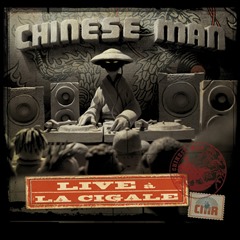 Chinese Man’s beatmakers are not of Asian or African descent and their musical style expands way beyond hip-hop, into reggae, electro-swing etc. Their imagery was also a important part of Afroasiatik, I especially wanted to re-use of the image of a character in a straw hat and turntables.
Chinese Man’s beatmakers are not of Asian or African descent and their musical style expands way beyond hip-hop, into reggae, electro-swing etc. Their imagery was also a important part of Afroasiatik, I especially wanted to re-use of the image of a character in a straw hat and turntables.
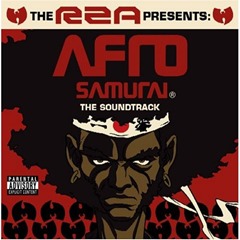 A final visual influence was the anime version of Afro Samurai. Some things annoyed me like the amount of gore, the sidekick character and the very simple plot, but I really liked the drawing style and the soundscape: a soundtrack by RZA and Samuel L. Jackson as voice actor mean happiness. The high-tech-and-kimonos aspect of the setting fit nicely with the constraint to have Afroasiatik set in the modern world.
A final visual influence was the anime version of Afro Samurai. Some things annoyed me like the amount of gore, the sidekick character and the very simple plot, but I really liked the drawing style and the soundscape: a soundtrack by RZA and Samuel L. Jackson as voice actor mean happiness. The high-tech-and-kimonos aspect of the setting fit nicely with the constraint to have Afroasiatik set in the modern world.
With this mix of influences, I had a pretty good idea of how the game would look like and sound like. it was time to narrow down what the game would be about.
Hip-hop themes
I wanted people to think and discuss about hip-hop themes. And not only the usual «guns, money, bitches etc» image that the media have been spreading. French hip-hop is a very rich culture and it will take many larps to cover every aspect of it, especially when looking at its long history. However, the zen garden was only available for rent outside of opening hours, so the game would need to be short, less than 5 hours. No time to develop complex narratives or deep exploration of subtle topics: things would have to be simplified. Just like the portrayal of Asian culture would be limited to the aspects that had been chosen by French hip-hop artists: martial arts, clothes, music.
So I settled on three themes. There could have been way more, e.g. the surge in experimental hip-hop using electro and house sounds since 2000, the influence of US hip-hop in French hip-hop, differences between French hip-hop and Swiss hip-hop etc. But I had to focus so I picked three. If you’re more into US hip-hop you may recognize similar phenomena that happened 5-10 years earlier over there, but again the game was about French hip-hop.
1) Early 1980s theme: hip-hop as an original culture and a playful form of non-violence, enabling competition and battling using dancing, graffiti, DJing, rapping or beatboxing -without fighting. «Peace, Unity, Love & Havin’ fun» even when living in a violent environment, as defined by Afrika Bambaataa at the beginning of Zulu Nation. This deeply influenced the beginning of hip-hop in France (see Dee Nasty in Part 1, often in duet with rapper Lionel D., IAM’s Unité but also later as a nostalgic streak in Alliance Ethnik’s hit single Respect)
2) Early 1990s theme: serious/conscious hip-hop as a political force, no more of those funny Rapper’s Delight things, time to get serious and express political criticism, highlighting social and political issues not necessarily witnessed by the media, or misrepresented. But also calling for actual change, sometimes through violence. This is the time where I believed that if rappers could leverage their audience to be politically active, they could have changed parts of French society. They either refused to do it or failed. In the US it’s of course bands like Public Enemy, in France this was Supreme NTM, Assassin, but also IAM. Political artists still exist, like La Rumeur, Kenny Arkana or Médine, but they have much less visibility than the following.
3) Since the early 2000s theme: hip-hop as a mainstream money-making machine, often exploiting violent street/gangsta imagery, objectification of women, musically mixing with R&B, glorification of selfishness or just plain catchy tunes. In France, Rohff, Seth Gueko, Kaaris. Some graffiti writers have gallery exhibits, some hip-hop dancers are part government-subsidized contemporary dance companies. Some of the highest sellers like Booba developed gangsta personae based on having robbed one cab driver when they were young. Reaching millions of people, mega concerts, albums sold out upon their release: this is the current “tip of the iceberg” state of French hip-hop.
Exploring these themes sequentially would have been interesting, e.g. over the course of one week-end, but I only had less than 5 hours. So I decided to explore them in parallel, represented by 3 different groups of hip-hop artists. Having them as opposing forces also enabled them to confront each other’s view. It would also make the players think about what hip-hop stood for. Because in the 2013 French hip-hop scene, talking about Zulu Nation or rapping for social change is delightfully nostalgic and quaint. But these have been important aspects of hip-hop, of why I love it so much and I felt important for players to discuss -and even embody- these elements. Especially if they only discovered hip-hop through mainstream media.
Then came to question of how to link these three groups with all the cultural references, and again Samurai Champloo was very useful.
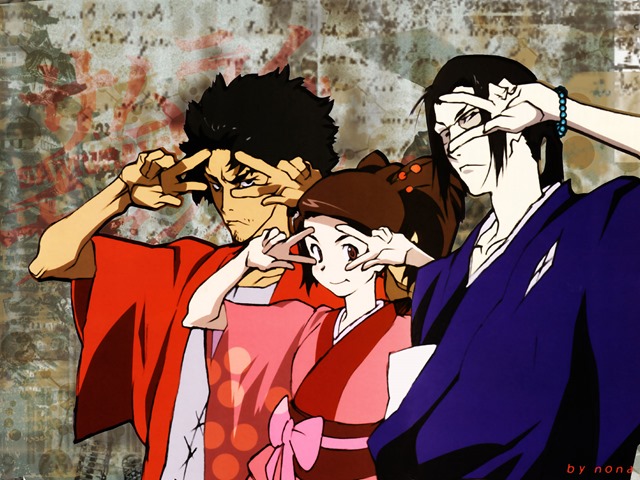
Building the game world
 With its rigid, serious attitude, Jin (right, in the above picture) would be perfect for group 2 above. Mugen (left) with his more relaxed looks, non-katana sword and violent, ganster connections, would be great for group 3. Fuu (center) with her bright colors, non-violence, and playful demeanor in a violent world, could somewhat represent group 1. The use of the color red in Mugen’s clothes reminded me both of China (rather than of Japan), and of IAM’s Red Black Green song, named after a Pan-African flag (see part 1). This combination reminded me of the many news reports about the massive Chinese investment in Africa. Trade between Asia and Africa is nothing new, and dates back centuries, but in recent years Chinese investments in Africa have hugely intensified. French media call this phenomenon Chinafrique (Chinafrica) in reference to Françafrique, the despicable habit of France meddling economically and politically with its former colonies while they are now sovereign nations. What if it went all the way? What if China and the African continent became one country, but on equal terms? To avoid confusing with current Chinafrica, I called the result Afrochina. Its colors would be red-black-green, and its animal the dralion, a mix between a dragon and lion, inspired by both traditional dancers at Chinese New Year celebrations and by the eponymous Cirque du Soleil show, which combined African and Chinese elements in the same global mix spirit.
With its rigid, serious attitude, Jin (right, in the above picture) would be perfect for group 2 above. Mugen (left) with his more relaxed looks, non-katana sword and violent, ganster connections, would be great for group 3. Fuu (center) with her bright colors, non-violence, and playful demeanor in a violent world, could somewhat represent group 1. The use of the color red in Mugen’s clothes reminded me both of China (rather than of Japan), and of IAM’s Red Black Green song, named after a Pan-African flag (see part 1). This combination reminded me of the many news reports about the massive Chinese investment in Africa. Trade between Asia and Africa is nothing new, and dates back centuries, but in recent years Chinese investments in Africa have hugely intensified. French media call this phenomenon Chinafrique (Chinafrica) in reference to Françafrique, the despicable habit of France meddling economically and politically with its former colonies while they are now sovereign nations. What if it went all the way? What if China and the African continent became one country, but on equal terms? To avoid confusing with current Chinafrica, I called the result Afrochina. Its colors would be red-black-green, and its animal the dralion, a mix between a dragon and lion, inspired by both traditional dancers at Chinese New Year celebrations and by the eponymous Cirque du Soleil show, which combined African and Chinese elements in the same global mix spirit.
The combination would be so powerful it could take over the world. But I wanted a modern day setting, not a futuristic one. So how could Afrochina have already taken over the world before 2013? I needed an alternate history where Europeans would not have fully colonized Africa and China. This brought back my history lessons about the Boxer Rebellion. Some of the Boxers believed that their faith and martial arts provided them with mystical super powers like being bulletproof. But what if their martial arts really worked? Then the colonizers would indeed be repelled, and the Dowager Empress Cixi would remain in power, getting rid of all who supported the colonizers.
Conquering Lion of the Tribe of Judah
Another heroic struggle again colonization was Haile Selassie’s I in Ethiopia. During a war against Mussolini’s fascist invaders, his 1936 discourse to League of Nations showed that so-called democracies would do absolutely nothing to help him, on the contrary. Haile Selassie did eventually win, but what if, like the Boxers, his soldiers had access to mystical powers? He would have won battle after battle, and possibly pushed his advantage as far as possible, i.e. all of Africa.
To reggae listeners, Haile Selassie’s name is often associated with «Jah Rastafari». Haile Selassie’s crowning was prophesied by Marcus Garvey, a Jamaican and Pan-Africanist leader: “Look to Africa, when a black king shall be crowned for the day of deliverance is at hand!”. In the full-blown colonization time of the 1920s, this was considered ludicrous. But Haile Selassie was indeed made Negus. His pre-coronation full name and title was Ras Tafari Makonnen Woldemikael. Hence the name “Rastafarians”, for people who saw Haile Selassie as a messiah and Marcus Garvey as his prophet. It is important to note that Haile Selassie was an Ethiopian Orthodox Christian, and that he freaked out during his visit to Jamaica when seeing thousands of Rastafarians worshipping him.
According to Rastas, he is a descendant of the union of King Solomon and Makeda, Queen of Sheba. So what better way to seal the union of Africa and China than a marriage? A strong empress (Longyu, successor of Cixi, for chronological reasons), a strong emperor, and boom, Afrochina was born. I would decide on whether to incorporate Rastas later.
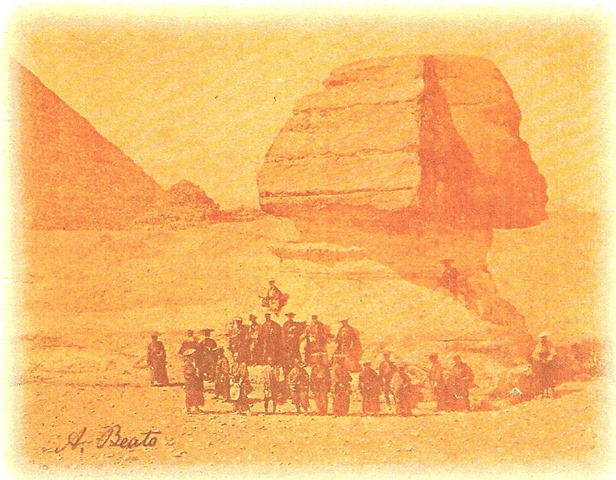
Not the last samurai
 So what of Japan? Samurai Champloo also deals with invaders, like Americans in the Baseball blues episode. And a major real life Afro-Japanese moment was seeing the above 1863 photograph of Samurai in traditional garb, posing in front of the Sphinx. Apart from the nice link with IAM’s Afro-Asian mix with an Egyptian focus, the historical aspect was actually very relevant to colonization. The original purpose of the trip was to ask Europeans to stop messing around with Japan. Later on, like the Boxers, Samurais were defeated by superior firepower. What if bushido actually made them resistant to bullets? They could also have defeated the invaders and, pushing their advantage, what if they had colonized the people that refused to stop interfering and tried to invade them? Southwest, they would be limited by Afrochina, but east and northwest they could expand and take over the USA, even Russia and northern Europe. Thus was born Shogunato, a mix of Shogunate and NATO (sometimes spelled ShoguNATO in the player material), due to NATO’s tendency towards neo-colonial behavior. The flag of NATO is blue with a white compass star, which loosely reminded me of a shuriken. Because pre-WWII Japanese flags are unknown to most players, and I asked my graphic designer to take the modern Japanese circle flag, make it blue and place a more identifiable shuriken inside.
So what of Japan? Samurai Champloo also deals with invaders, like Americans in the Baseball blues episode. And a major real life Afro-Japanese moment was seeing the above 1863 photograph of Samurai in traditional garb, posing in front of the Sphinx. Apart from the nice link with IAM’s Afro-Asian mix with an Egyptian focus, the historical aspect was actually very relevant to colonization. The original purpose of the trip was to ask Europeans to stop messing around with Japan. Later on, like the Boxers, Samurais were defeated by superior firepower. What if bushido actually made them resistant to bullets? They could also have defeated the invaders and, pushing their advantage, what if they had colonized the people that refused to stop interfering and tried to invade them? Southwest, they would be limited by Afrochina, but east and northwest they could expand and take over the USA, even Russia and northern Europe. Thus was born Shogunato, a mix of Shogunate and NATO (sometimes spelled ShoguNATO in the player material), due to NATO’s tendency towards neo-colonial behavior. The flag of NATO is blue with a white compass star, which loosely reminded me of a shuriken. Because pre-WWII Japanese flags are unknown to most players, and I asked my graphic designer to take the modern Japanese circle flag, make it blue and place a more identifiable shuriken inside.
So I had my two empires, Afrochina and Shogunato. One focused on the Northern hemisphere, colder regions, influenced by more sober Japanese esthetics. This matched the character of Jin very well, and could go with group 2).
The other one was more Southern, more heterogeneous and vibrant but I wasn’t sure on whether to map it to hip-hop themes 1) or 3).
Jamaica and hip-hop
As a giant conquering empire, Afroachina did not exactly strike me as peaceful. That’s where Rastas came back. «One love, peace and unity» is a Rasta motto, nicely recycled in the «Peace, Unity, Love and Havin’ Fun» later developed by the Zulu Nation. So what if hip-hop was actually invented by Rastas? It is of course a stretch, but not more than magical martial super powers. DJ Kool Herc, one of the inventors of hip-hop music, was born in Jamaica and rapping to a beat has some of its roots in the dance hall DJs of Jamaican sound systems. And to perfectly close the loop with French hip-hop, dance hall reggae and hip-hop developed together in France. One of the reasons may be the fact that parts of France are in the Caribbean region (Martinique and Guadeloupe are close to Jamaica) and French people from the Antilles represent an important community in Paris, the birthplace of French hip-hop. In any event, Rapattitude, the very first French rap compilation, actually had 30% dance hall reggae tracks (or raggamuffin as we called it at the time). It even sold thanks to one of those, the hit single Peuples du monde (Peoples of the world) by Tonton David. Lyrics include both reference to African suffering, Marcus Garvey and preaching peace among black and white people.
Tonton david – peuples du monde par trapux
So if I had my two blocks, I wanted the Rastas to be neutral, hence they needed to have cultural elements of both blocks. To make sure Rastas would be linked with Shogunato, I would say that they followed the way of bushido, taught to them by the 1836 samurai visit, thus creating the Samurasta. The flag would be red gold and green, the Conquering Lion having is scepter replaced by a katana and the crown by an element from a samurai helmet.
To link them with Afrochina, they would see Haile Selassie as the messiah. But to provide some conflict, he would not be positively seen in Afrochina anymore. So I demoted Haile Selassie, like he was demoted by military coup and decided that Afrochina would be the People’s Republic of Afrochina, which still matched the red theme.
By being entrenched in the past, and by being a bit of both blocks, Samurasta would be neutral and despised by the large blocks. I reused the Cold War themes, with Afrochina hating Shogunato, and making both blocks very controlling dictatorships, Shogunato leaning on fascism and Afrochina on a rather messy form of communism.
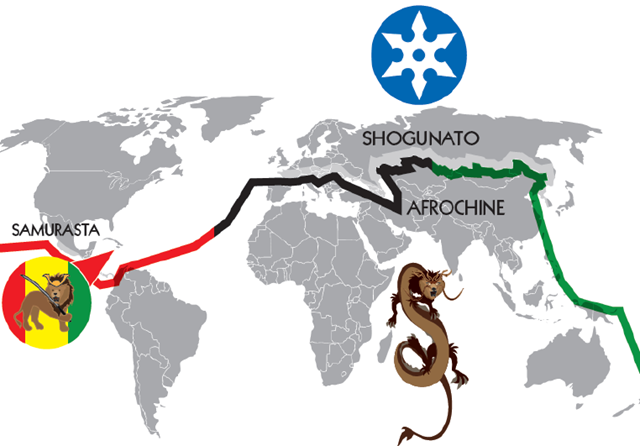
Linking all this back to hip-hop
Hip-hop, spread by the Samurasta through their zen garden enclaves, would preach cross-block unity. And therefore would be oppressed: in a Cold War setting, any person preaching unification with the enemy could be seen as traitor to their block. This meant hip-hop fans would need to defend themselves against oppression, hence had to arm themselves. And the most powerful weapon in the world of Afroasiatik, as shown by history, was martial arts. So martial arts were added to the regular four elements of hip-hop, thus bringing them to a nice five like in Asian philosophies.
This oppression also gave all players a sense of belonging, of fighting for a cause. It would limit the nationalistic aspect of the blocks, and also avoid mass battles (which the garden did not allow). The sense of being all part of a movement was actually pretty important in late 1980s-early 1990s France, and it was a feeling I wanted the players to experience.
However, I didn’t want everyone to be friends. Afroasiatik hip-hop may have started with the Samurasta, but it evolved differently in different environments. Just like in the real world French hip-hop is different form Brazilian hip-hop and different from American hip-hop. So I wanted to use the 3 themes as reasons for infighting in the hip-hop community.
SPOILER ALERT – Stop reading here if you plan to play Afroasiatik
The three blocks could be roughly matched to the three hip-hop groups mentioned and summarized as such:
1) Samurasta
No geographical area apart from zen garden enclaves and headquarters in Jamaica. A philosophy reaching across blocks, spreading positive vibes of Peace, Unity, Love and Having fun. Looks would be red, gold, green kimonos and dreadlocks. Style of hip-hop: old school, positive lyrics and some dance hall reggae like in the beginning of French rap. Hip-hop agenda: peacefully coming out to the world and explaining, Hare Krishna style.
2) Shogunato
Japan, northeast Europe, north America, patriarchal imperial regime. Due to the harshness of the centralized government, hip-hop is very cold and political. Hip-hop agenda: armed combat against the dictatorship of the blocks, overthrowing the government or at least obtaining a separate land, using nuclear terrorism if needed
3) Afrochina
China, Africa, Oceania, southwest Europe, south America. Matriarchal somewhat communist regime. Hip-hop is warmer, using more melodic elements. Hip-hop agenda: Afrochinese hip-hop is currently undergoing a crisis. Its more extreme elements actually advocate making it commercial and using magic for mind control if needed.
Of course each group had exceptions, people disagreeing with their main hip-hop agenda so that they could have their internal struggles. Not every Samurasta was peaceful, not every Shogunative was strict and stubborn.
So what of race?
Characters were from all over the world, representing the best of each block in each hip-hop discipline. Race was not an issue, because of the size of the blocks. There would by definition be more African and Asian people in Afrochina, and more Asian and Caucasian people in Shogunato. But since each block colonized half the planet, each citizen could be of any ethnic group. Therefore, no race was mentioned in the character sheets. The game events were set in Switzerland, and like for the Shadowrun game, I used the Röstigraben, the cultural divide between French- and German-speaking Switzerland. This put a physical and political block border on top our real world’s linguistic one. All players were French speakers, most likely Caucasian by US classifications (we do not use racial classifications for various reasons, including their use by the Nazi collaborators of the Vichy government during WWII).
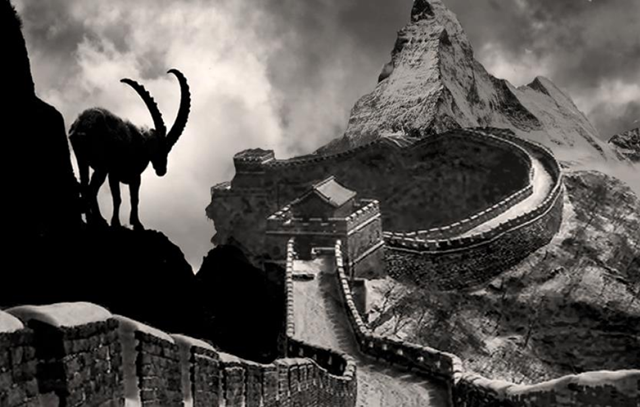
The Great Wall of Afrochina in Switzerland, going through the Alps, protecting the People’s Republic from their northern invaders.
I am specifying this because of questions, mostly from American larpers, about the Afroasiatik video. As said, like in the real-world version of 2013 France or Switzerland, characters in Afroasiatik could be of any color. Because of the absence of specification, a player asked whether he could try to darken his skin. His character was a rapper called Chen Minamoto, the leader of the Samurastas, and his character sheet, mostly written in rhymes, did not mention anything about a country of origin or race. The player interpreted the character as darker than him, and wanted to test whether he could do a credible makeup that would last the whole game. I said yes on the condition that he did not go into caricatures like Tintin in the Congo. He said he would try to reach a Tropic Thunder style of makeup with his limited skills and budget. As a Samurasta he dressed accordingly, wearing a kimono cut in the waxprint fabric traditionally used for boubous, in perfect Afro-Asian fusion. I was not too impressed by his wig but liked his idea of wearing the pakol as a nod to Commander Massoud to convey the image of a freedom fighting leader. Another Samurasta player went for blond dreadlocks, others went for different hairstyles.
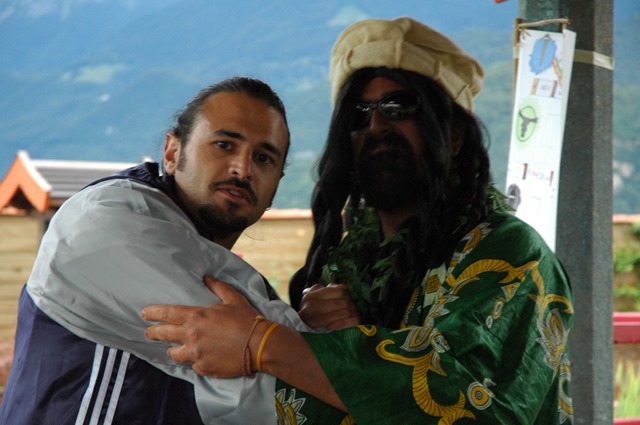
ChoCK Eddy, Shogunato MC, left, and Chen Minamoto, Samurasta MC, right, clasp hands after a friendly dissing battle. (Photo © Valérie Bauwens)
This was not the first time a “player-chosen race” approach was taken by French or Swiss larpers. In Le Four Fantastique’s Shadowrun larp, characters also were from all over the world, and the sheets did not specify any race (we did specify elves, orcs etc because those required facial prosthetics). Some people interpreted their characters as of race different than theirs and put on makeup appropriately. But neither in Afroasiatik nor in Shadowrun did players portray these characters in the stereotyped caricature way described in the “blackface” wikipedia article. Obviously you weren’t present at the games, but can see the Shadowrun looks in the video below, and in the Shadowrun article in States of Play Solmukohta book 2013.
Shadowrun was not about race: it was about shadowrunning: breaking into warehouses, hacking 3D environments, shooting stuff and surviving your mission in a cyberpunk world, for less than 5 hours. The character’s skin color did not matter.
Afroasiatik was not about race either: it was about rapping, dancing, graffiti writing, DJing, martial arts, and about the fate of hip-hop as a resistance movement, all in a world where the dominating cultural elements were Afro-Asian instead of Euro-American, for less than 5 hours. The characters’ skin color did not matter.
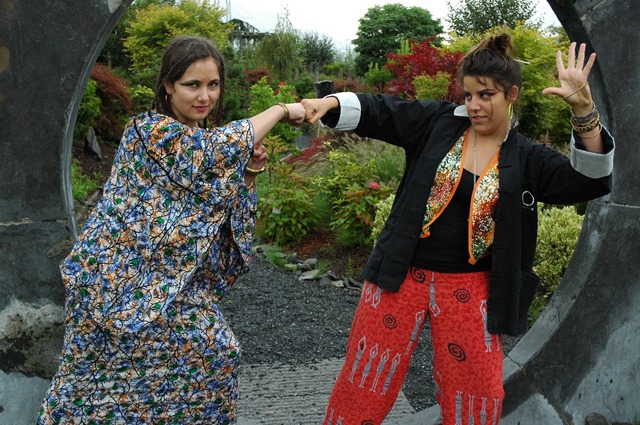
Olympe2Gauge and Blingz, best MCs in Afrochina (Photo © Valérie Bauwens)
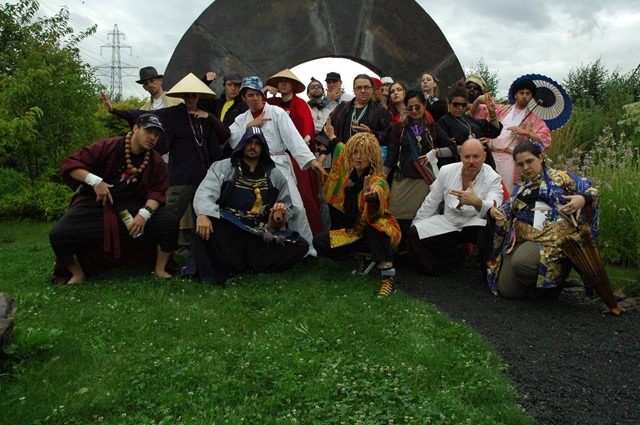
Afroasiatik characters (Photo © Valérie Bauwens)
Choosing sides
Obviously the players did not have to read my whole design thought process like you just did. The goal was not to write a whole RPG supplement for such a short game. The game world description (including hip-hop definitions and an alternate timeline) took a total of 10 illustrated pages in the player booklet. All they needed to know were: the musical and visual inspirations, high-level cultural elements of the blocks and what hip-hop meant in this world.
Because most of the players didn’t know much about hip-hop, they did not have a strong preference for one of the three hip-hop agendas. However, they did have a strong preference for what type of hip-hop performance they could give, so this was a key part of the casting process. To make things easier, I allowed slam poetry as a type of MCing, and martial arts were one of the five elements of hip-hop. So even the not-so-artistically inclined could perform by fighting. I also left an exit door by leaving a role of the presenter, introducing the acts and breaking ties in jury votes if needed.
Another important factor in casting was what type of clothes the players already owned. The underground nature of the movement meant people were not supposed to dress too much in hip-hop clothes to avoid government spies. Western clothing in general was frowned upon, but not every player already had African or Asian clothing. Due to site rental costs, game would be priced at 60 CHF (65 USD) for 3 hours of workshops and max 5 hours of in-game time, without full meals or lodging, so I wanted to make it affordable by enabling people to reuse what they already had in their wardrobes.
Next part: the plot, rules and combat system, how the game actually went, success, failures and what I would do differently next time.
Related
3 Responses to Afroasiatik – a kung-fu hip-hop larp – recap part 2
Leave a ReplyCancel reply
No Trackbacks.
Tags
2013 afroasiatik burlesque conquest of mythodea convention critique défi XVIIIème english français french french larp gn gniales gnidee hip-hop huis clos jdr jeu de rôle jeu de rôle grandeur nature knudepunkt knutepunkt kung-fu lacepunk larp le four fantastique murder party mythodea nodal point nordic larp old news orc'idée podcast radio roliste rap review roliste sk2012 solmukohta steampunk stim suisse swiss larp switzerland thomas b. XVIIIèmePeeps be commentin’
- GEESAMAN8 on Deux GN avec du Star Wars dedans, un marathon et de l’oralité
- Steampunk Props Part 3: Gun, Smoke Rings video, Bubbles, a Chandelier and Art by Latranis - Thomas B. on Cheese-eating larper monkeys: the GNiales 2011 recap
- I'm a size 47 media whore and here's what sells online - Thomas B. on And they piss like I cry over unfaithful women
Search



[…] NSFW – Slaaneshifying Sornob: boobs for the boob god!* ( Mythodea 2013 recap part 2 of 3 ) Afroasiatik – a kung-fu hip-hop larp – recap part 2 […]
[…] Afroasiatik – a kung-fu hip-hop larp – recap part 2 […]
[…] that asked for a playlist, start with the video links at the end of this blog post, then go to part 2. For those that asked for more workshop videos, design methods etc, please contact me privately. […]